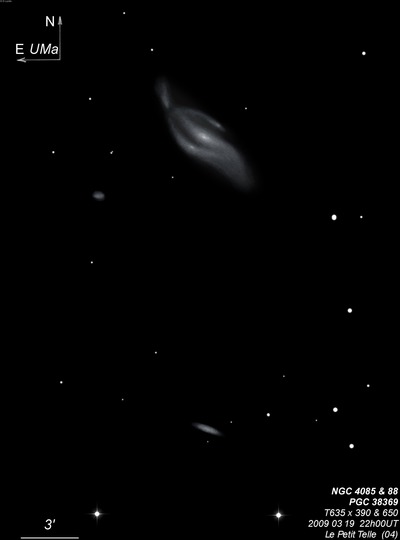
William Herschel discovered NGC 4088 = H I-206 on 9 Mar 1788 (sweep 816) and logged "cF, E, about 4' long." His summary description from 3 observations reads "cB, E, 45° np sf, 6' long, 4' br, almost equally bright." Heinrich d'Arrest made 3 observation, the earliest on 4 Dec 1861.
Sir Robert Ball, observing assistant at Birr Castle on 28 Mar 1867, recorded "vB, vL, E 53.5°. A new spiral with probably many details of interest, of an S shape. There is certainly a brighter portion sf the nucleus with a dark lane between them. Likewise, a similar brightness np the nucleus. I thought the darkness did not extend all round the centre. There can be little doubt of the curved branch following, it seems to proceed in the direction of a star nf."
200/250mm - 8" (3/28/81): fairly bright, elongated SW-NE, weak concentration, cigar-shaped. Forms a pair with NGC 4085 11' SSW.
400/500mm - 17.5" (4/13/91): bright, fairly large, elongated 5:2 SW-NE, 5.0'x2.0', mottled patchy appearance, small elongated brighter core but no nucleus. A mag 15 star is 2' off the NW side. Faint spiral structure is visible with concentration. An extremely faint arm is off the NE end curving towards a mag 14.5 star to the NE 3.7' from center and a second extremely faint arm is just visible off the SW end curving to the south. Forms a pair with NGC 4085 11' SSW.
900/1200mm - 48" (4/4/11): this is a showpiece spiral in the 48-inch with the startling eyepiece view matching the detail in the DSS image. The galaxy extended 5.5'x2.0' SW-NE. Near the center is an elongated, extremely bright core. The very bright central portion extends from the core in a roughly 2'x0.5' region towards the southwest but is concave a bit, bending slightly towards the south. This feature appears similar to a slightly distorted central bar. Just south of this central bar is a dust lane extending SW to NE that parallels the bar, though it is more contrasty to the northeast of the core.
The dust lane separates the bright bar feature from a very long arm that extends the entire length of the galaxy along the south side and vaguely emerges from the southwest end of the bar. This arm is clumpy with a couple of large, bright knots to the south of the core and another prominent knot towards the east end of the galaxy (1.7' NE of the core). Beyond this knot the arm quickly dims, fans out a bit and bends to the north towards a mag 13.5 star.
Emerging from the northeast end of the core is a second prominent arm that immediately doubles back towards the southwest on the north side. This arm nearly parallels the central bar to the north and is separated by a less contrasty darker strip or lane. This clumpy arm contains a fairly prominent knot only 0.6' NW of the core. After this point the arm dims dramatically continuing a bit further southwest. The two main arms, along with the central bar create a squashed irregular "Z" appearance.
MCG +09-20-092, which lies 5' SE in the field, appeared faint, small, round, 20" diameter, fairly low even surface brightness.
Notes by Steve Gottlieb